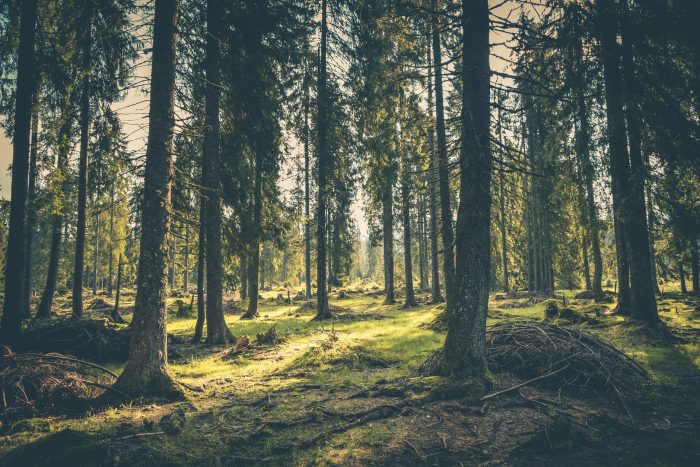Almost every day, I find myself lying in the lush grass, watching birds, bees and butterflies flew over me, listening to the songs of birds and distant sounds of water splashing here, in the Scottish wilderness. Sun rays shining over the branches of trees or traking clouds on the clear blue sky. A true therapy.
Our lives have become incredibely fast-paced and “plugged-in” leading many of us to feel disconnected from nature and from ourselves.
We forgot something important, which was known by our ancestors: spending time in nature, and specifically among trees in a forest, has a calming effect.
Shinrin-yoku (森林浴 forest bathing) – a term coined in 1982 by the Director General of Japan’s Agriculture, Forestry and Fisheries Agency, Tomohide Akiyama – means the grounding experince of spending time in a forest. It became a therapy but it’s not a brand new thing. It’s something our human soul naturally craves if we learn to listen to it. But it also means that now it’s sientifically proven that nature heals. In the past 15 years or so consistent scientific results have added weight to the idea of forest bathing as a preventative medicine. Results point to increased mental wellness, boosted immune systems and reduced stress levels, heart rate and blood pressure. And so the term ‘forest therapy’was born.
The positive effects of Shinrin-yoku can be tracked back to 3 things: calm atmosphere, gentle exercise, and actual interactions with trees. Research found that after a forest-bathing trip, subjects had significantly higher numbers a type of lymphocyte that boosts the immune system’s defences against viruses and cancers – the effect actually lasted for 7 days after the experience.
Our therapy session started with washing our hands in a small stream, feeling the coolness of the water and listening to its sounds as the water fell over bigger rocks and poured down in tiny waterfalls. A slow hike took us to the base of a gulley, where we overlooked the sea and the neighbor island with its mountains in the distance. We stopped for a short water break, some trail mix was shared and we begun our first silent exercise. We had to pick a direction, and look in the far distance, then middle, then up close, to see how the view changed depending on what we focused on. Our guide was playing gentle music in the background. If the weather allows we walk around bare feet to sense the surfaces beneath us and often, we meditate with our backs touching the trees to soak in their healing powers. What happens in the session depends greatly on the guide, the location, the season and the actual weather.
We saw deer in the distance and squirrels playing on branches. Birds hopping from branch to branch playfully. Bumble bees pollinating flowers.
But it is not just forests that have a beneficial effect on our well-being. Parks, flowers or even pieces of wood have been shown to reduce stress, making these effects attainable for everyone. You don’t have to be on an official trail, with a guide to indulge in the healing powers of trees. A guide is great to give you an idea of what to look out for but you can go on your own forest bathings in the wilderness, too. Even walking, hiking or doing yoga in nature, climbing trees, hugging or talking to them, sitting with your back to a tree while reading a book counts as well.
Here are some of my favorite tips for forest bathing lone.
- Walk slowly. And by slowly I mean slow your pace by half. And by half again.
- Be present. Keep your phone turned off.
- Use all your senses to explore your environment. Notice how the ground feels under your feet, the sound of the wind, the light peaking through the leaves and shadows playing. Look up, down and around.
- Touch things. Notice how different grass, soil, branches, petals and leaves feel.
- Notice where things are in their life cycle. What is growing? What is fading?
- Breathe deeply. Fill your lungs with fresh air. What do you smell?
- Watch the sky.
- Count colours. How many shades of one colour can you see? Watch long enough to notice changes.
- If you can identify what is edible, taste a berry or a leaf slowly, and explore the flavors.
- Pick up a fallen branch, pine cone or leaf and look at it closely. What can you see?
- Spend some time in silence. Try meditating, stretching or just sitting with your back against a tree.
- Take off your shoes and feel the earth beneath your feet or dip your toes in a stream.
- Don’t rush. Linger as long as you can.
- Find a particular spot you are drawn to and spend time there. Name it. Come back in another season, and see what has changed.
For a long time, I couldn’t formulate why I love to be in nature so much – it recharges me and I don’t have to subscribe to any societal rules, I become one with nature so to speak. I feel more at home and “more me” than in my own house. When I spend time in a forest and experience moments of mindfulness among the trees, I feel held, supported, transported.
Taking time to step out of those boxes and get close to the wild outdoors sharpens our senses and reminds us of the preciousness of life. We need the simplicity to remind us that life isn’t all about accumulating stuff. And we need the birdsong and big skies to remind us that wildness is a part of who we are.







Read 1 comment and reply